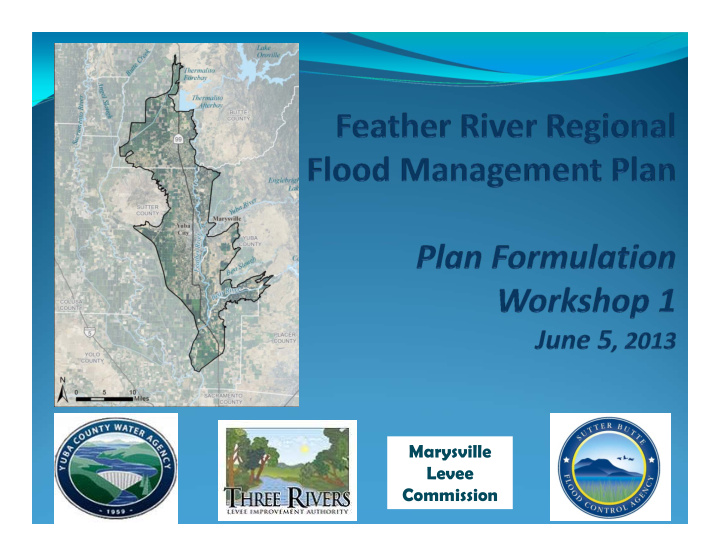



Marysville Levee Commission
Welcome Introductions and Housekeeping Meeting Objectives Gain understanding of FRRFMP and connection to CVFPP Why the FRRFMP matters Share rough draft of FRRFMP elements Describe ways to participate in the FRRFMP
Agenda Welcome, Introductions and Agenda Review Regional Planning: What is it and why now? Stakeholder Participation: Why get involved? Opportunities for involvement Review of draft plan Q and A Breakout Stations Agriculture CVFPP/Basinwide Studies Emergency Response Environmental/Recreation Finance Urban
Memorandum of Understanding Partner Agencies: Sutter Butte Flood Control Agency (SBFCA) Marysville Levee Commission (MLC) Three Rivers Levee Improvement Authority (TRLIA) Yuba County Water Agency (YCWA) Marysville Levee Commission
Feather River Regional Flood Management Plan Purpose: Build upon the CVFPP by describing regional flood management challenges and deficiencies, identifying solution strategies and projects, setting priorities, and developing a local financing plan for their implementation which leverages local, State, and federal funding opportunities. Duration: 18 months Budget: $1.1M Funding : DWR Grant
Coordinating Committee Steve Lambert primary; Bill Connelly alternate (SBFCA/Butte County) James Gallagher primary; Kash Gill alternate (SBFCA/Sutter County) Dave Lamon primary; Al Montna alternate (SBFCA/LMAs) Mary Jane Griego primary; John Nicoletti alternate (YCWA/TRLIA/Yuba County) Patrick Ajuria primary; Jerry Crippen alternate (Marysville Levee District) Roger Abe primary; Sardeep Atwal alternate (YCWA/Yuba County) Agency Staff: Curt Aikens, Robert Bendorf, Paul Brunner, Mike Inamine
Feather River RFMP Team MBK Engineers – Program Management GEI – Plan Formulation and Engineering Downey Brand – Strategic Planning and Legal Kim Floyd Communications – Public Outreach Seth Wurzel Consulting – Finance Plan Environmental & Agricultural Team ICF International – Team Lead Ascent Environmental, HDR, H.T. Harvey, Westervelt, and CBEC
Feather River Regional Stakeholders 4 Counties – Sutter, Yuba, Butte, and Placer • 6 Cities – Yuba City, Live Oak, Biggs, Gridley, • Marysville, and Wheatland 4 Flood Control Agencies – Sutter Butte Flood Control • Agency (SBFCA), Three Rivers Levee Improvement Authority (TRLIA), the Yuba County Water Agency (YCWA), and the Marysville Levee Commission (MLC) 9 LMAs – RDs 10, 784, 817, 2103, 1001, LDs 1 and 9, • Marysville Levee District and State Maintenance Areas (MAs) 5, 7, 13, & 16 (DWR Sutter Yard) 2 Small Communities – Rio Oso and Nicolaus • 21 Currently identified Stakeholder Groups – Including • Farm Bureau, Growers, Enterprise Rancheria, Environmental groups/NGOs, Water groups, Chambers of Commerce, Schools, Building and Realty groups, and Citizen and Neighborhood associations
Outreach Approach Stakeholder identification Feather River Regional Plan website: http://frrfmp.com Regional plan hotline: 530 ‐ 845 ‐ 5988 Small ‐ group meetings Planning meetings (governance) Public workshops (3) Updates to Cities/Counties/Resource Agencies Outreach materials (electronic communications)
Planning Approach Flood Management Goals and Objectives Problems and Opportunities Solution Strategies and Management Actions Alternative Formulation Alternatives Evaluation, Comparison, and Priorities Residual Risk and Floodplain Management O&M Emergency Response Planning Land Use and Environmental Enhancement Financial Plan
Goals and Objectives 200 ‐ year protection for urban areas 100 ‐ year protection for small communities Improved flexibility and sustainability Strengthen regional economy Modify State/federal regulations to support agriculture in floodplains
Goals and Objectives: Agricultural Preservation & Ecosystem Enhancement Principles Support a vibrant, sustainable agricultural economy Harmonize ecosystem enhancements with existing local and regional land uses to the extent feasible, including agriculture and other ongoing regional habitat enhancement efforts Achieve habitat objectives through agriculture where feasible
Problems Regional levee system deficiencies Channel capacities and management Reservoirs Fisheries and wildlife habitat Flood system operation and maintenance Water Quality Increasing flood risks—development and weather patterns Levees and floodplains—Decertification and remapping Land use conflicts Funding limitations
Opportunities Leverage a variety of State, federal, and NGO funding sources Alignment with Basin ‐ Wide Feasibility Studies Regional habitat enhancement planning—reduce regulatory constraints Improving levee repair technology Improving forecasting technology
Solutions Levees: Structural improvements, setback levees, ring levees Channels: Erosion repairs, sediment and vegetation management, corridor management plans, streamlined permitting Reservoirs: Re ‐ operation and structural improvements Streamline permitting for projects and O&M Residual risk management incentives, programs, opportunities, including personal emergency preparedness
Key Project Elements Urban flood management projects Small communities flood management projects Rural Levee Repairs Non ‐ structural measures and improved emergency response Coordination with DWR’s Sacramento River Basin ‐ Wide Feasibility Study, other RFMPs, and the USACE Central Valley Integrated Flood Management Study
CVFPP Conservation Strategy The Conservation Strategy is: A supporting document of the CVFPP Identifies ecological needs in each Region Helps in development of multi ‐ benefits projects and permitting for individual projects and long ‐ term operation and maintenance Element of system ‐ wide permitting strategy
CVFPP Conservation Strategy Next Steps Public technical workshops began in early May Opportunity to identify ecological needs, indicators, targets, and objectives For more information: Tony Danna: Jack.Danna@water.ca.gov (916) 651 ‐ 0189 http://www.water.ca.gov/floodsafe/fessro/floodway/conservation/
Financial Plan High ‐ level analysis evaluating the financial feasibility of implementing the identified and prioritized projects Three key steps: Review regional economic setting and growth profile of the region Evaluate potential non ‐ local funding sources Identify and evaluate feasibility of identified local funding sources
Questions?
Recommend
More recommend